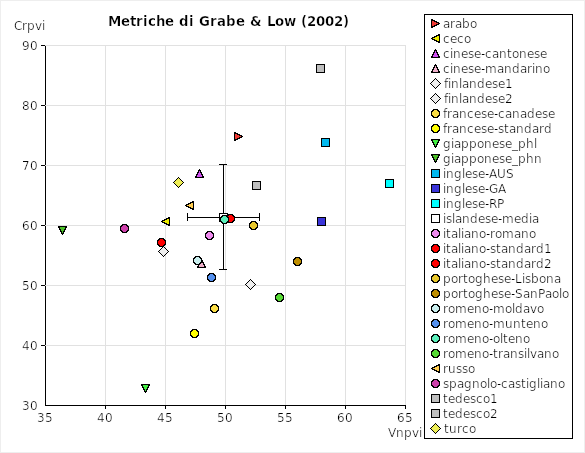The PVI
Grabe & Low (2002) proposed a rhythm metric which differs from the deltas and the varcos in that it takes into account the temporal succession of the vocalic and consonantal intervals instead of joining all the values and calculating the standard deviation. The formula of the rPVI (raw Pairwise Variability Index) is the following:

It computes the difference in duration between each interval and the one that follows, then calculating the average of all differences. Grabe & Low (2002) suggest that the formula of the rPVI should be used for the consonantal intervals, while the formula of the nPVI (normalized Pairwise Variability Index) should be used for the vocalic intervals, which are more prone to undergo the influence of speech rate:

It computes the difference between the duration of each vocalic interval and the one the follows then divides it by the average duration of all vocalic intervals. The mean of the values obtained is computed and finally multiplied by 100. So, the nPVI actually applies to the rPVI the same normalisation that the varco applies to the deltas. Authors' expectations for the PVI are of course similar to those for the deltas, therefore the so-called syllable-timed languages should have higher values of rPVI and nPVI than the so-called stress-timed languages.
Members of the staff of the Laboratory of Experimental Phonetics of Turin tried to compute these parameters on a broader sample of languages; the results are shown in the charts. The data consist of the narrative The North Wind and the Sun translated into various languages and read by professional or standard speakers (we have used some of the illustrations of the Handbook of the IPA and of the Journal of the IPA, but many samples have been recorded in our laboratory). The recordings have been accurately segmented and annotated independently by Antonio Romano and Paolo Mairano and the final results consist of the average of the values obtained by the two authors. Every dot in the chart corresponds to one speaker (except for Icelandic, for which we have 1 dot for 10 speakers to avoid confusion - the error bar indicates the standard deviation between the results obtained for each of the 10 speakers). The values of the correlates have been computed with the help of Correlatore, with which we have also built the charts.
A detailed discussion of the results can be found in our publications (see the bibliography below). However, it should be noticed that languages traditionally considered as syllable-timed (Italian, French, Spanish, ...) are roughly situated in the lower left corner of the chart (with low values of both rPVI and nPVI), whereas languages traditionally considered as stress-timed (English, German, ...) are roughly distributed in the upper right corner of the chart (with high values of both rPVI and nPVI).

| Essential bibliography | |
|---|---|
| Grabe, E. & Low, E. L. (2002) Durational variability in speech and the rhythm class hypothesis. In Gussenhoven, C. & Warner, N. (eds.) Papers in Laboratory Phonology 7, Berlino, Mouton de Gruyter, 515-546. | |
| Mairano, P. & Romano, A. (2007) Inter-subject agreement in rhythm evaluation for four languages (English, French, German, Italian). Atti del XVI ICPhS (International Congress of Phonetic Sciences), Saarbrücken, Germania, 6-10 agosto 2007, 1149-1152. (PDF) | |
| Mairano, P. & Romano, A. (2007) Lingue isosillabiche e isoaccentuali: misurazioni strumentali su campioni di italiano, francese, inglese e tedesco. Atti del III Convegno Nazionale AISV (Associazione Italiana di Scienze della Voce), ITC-IRST Povo (TN), 29 novembre - 1 dicembre 2006. | |
| Mairano, P. & Romano, A. (2008) Distances rythmiques entre variétés romanes. In: Turculeţ, A. (a cura di) La variation diatopique de l’intonation dans le domaine roumain et roman, Iaşi: Edizioni Universitarie "Alexandru Ioan Cuza", 251-272. | |
| Mairano, P. & Romano, A. (2010) Un confronto tra diverse metriche ritmiche usando Correlatore. Atti del V Convegno Nazionale AISV (Associazione Italiana di Scienze della Voce), Università di Zurigo, 4-6 febbraio 2009. | |
| Romano, A., Mairano, P. & Pollifrone, B. (2010) Variabilità ritmica di varietà dialettali del Piemonte. Atti del V Convegno Nazionale AISV (Associazione Italiana di Scienze della Voce), Università di Zurigo, 4-6 febbraio 2009. | |
| Romano, A. & Mairano, P. (2010) Speech rhythm measuring and modelling: pointing out multi-layer and multi-parameter assessments. Atti del convegno Les Universaux Prosodiques, Université Sorbonne Nouvelle, Parigi, Francia, 15 ottobre 2008, Roma: Aracne Biblioteca di Linguistica |